Total Design in the Design and Development Process of a Remotely Operated Vehicle (ROV) with Particular Consideration of Sensorization
Abstract
:1. Introduction
1.1. Background
- Vessel: this is mainly where the central control cabin is located, from which the pilot controls the ROV, the vessel power and the launch and recovery system (LARS) for large ROVs.
- Umbilical: this is a connector that connects the vehicle with the surface, allowing the supply of energy and the transmission of information. In ROVs of considerable size, the tether management system (TMS) must be considered, which facilitates the launch and recovery of the vehicle and provides protection to the vehicle during its launch and recovery.
- ROV: this is the vehicle in charge of carrying out tasks in the environment. This will have technical characteristics such as depth of reach, speed, battery autonomy, weight, payload, according to the application to which it is intended.
1.2. Literature Review
1.3. Objectives
- Examining the state of the art of the design and development of ROVs.
- Studying methodologies of engineering design
- The proposal and application of Pugh’s Total Design model to a ROV design and development project.
2. Methods and Materials
2.1. Total Design
- The design core encompasses six design cores belonging to the six stages integrated in the model and whose graphic representation is made vertically with several links that correspond to each stage (Figure 2). The established stages are: core design 1: market/user needs and demands, core design 2: the product design specification, core design 3: conceptual design, core design 4: detail design (technical design), core design 5: manufacture and core design 6: selling (marketing). These stages help the engineer or design team to treat the PDP systematically, being able to adapt the methodology to the product.
- PDS refer to technical, market, manufacturing, etc., considerations, and their objective is to limit those parameters and main requirements in the product, preparing a list with qualitative or quantitative specifications in the form of limit values or specific values if they are known. Each phase defined in the design core has its own PDS which are represented around the stages and ordered based on their importance for the stage (Figure 2). The design core enveloped by the PDS thus integrates the activities systematically to structure the PDP.
2.2. Review Methodology
- Time criterion: search and analysis of publications produced between 2016 and 2021.
- Context of the concept: articles focused on ROVs were selected, with special interest in those dealing with sensorics in ROVs.
- Methodological framework criteria: special interest was given to publications in which the PDDP of an ROV is structured following some design model or methodology from the early stages of the process.
3. Results and Discussion
3.1. Total Design in ROV System Design and Development
3.1.1. Design Core: Market
- Definition of the product and the market: define the objective of the generic use of the ROV, classifying it into research tasks or subsea operation tasks. The scope of the research or the sector of application must be specified. For this first stage, it is proposed to incorporate the taxonomy of problems of R.B. Frost [52], which establishes seven key factors for the organization and classification of problems from which the most suitable for this proposal are selected, being: (1) the type of entity being designed, (2) the degree of innovation involved, (3) the extent to which the designed entity can be conceptually decomposed into subsystems, (4) the availability of adaptable solution concepts, (5) the simplicity or complexity, (6) the degree of interaction within the solution and (7) the looseness or tightness of the constraints or requirements which the design must satisfy.
- Identification of reference users and collection of information: in this case, it is proposed to apply the requirements elicitation technique [53] to obtain the ideal technique for each ROV system project based on the information in the previous point. For the choice of an elicitation technique, there are attributes to consider, of which attention will be focused on the following attributes: level of available information, moment of application (in this case, early stage of the project), type of information to elicit (in this case needs), the degree of definition of the problem, the consensus between the users (experts) and the time constraint of the project. This methodology proposes 17 possible techniques, from which the most suitable ones will be selected according to the project. As a result of application, the application of open interviews and structured interviews with experts is recommended. Table 1 shows an example of basic questions to incorporate in a structured interview.
- Interpretation of user data from the need: the data obtained in the previous phase must be translated into user needs based on the UNE-EN 16271:2013 regulation [54]. Necessity is understood as those problems that users want to solve by using the ROV. It may also be of interest to collect information on user expectations, understood as the value that users expect to obtain from the product and the user experience, as well as a series of requirements. The needs analysis to define the PDS must be articulated and approved before proceeding with the following steps [55].
- Organization of needs and hierarchy: for the organization of needs, it is proposed to group them based on the information obtained, resulting in the following classification in the case of the ROV: basic, user, technical, innovative, corporate and regulatory framework needs. Subsequently, it is proposed to carry out a hierarchical analysis of needs in which they are defined based on the importance they have with respect to the objective of using the ROV. To carry out the hierarchy of needs, it is proposed to incorporate a binary dominance matrix, a matrix of paired comparisons, and in cases of greater complexity, the technique of the weighted technical value can be incorporated, understanding the complexity of the needs as the degree of difficulty in to satisfy that need. The weighting result of the needs has been included in Figure 9.
3.1.2. Design Core: The Product Design Specification
3.1.3. Concept Design
3.2. Proposal of Sensorization through Total Design
- Flow module: one sensor (Sensor 1). This sensor is independent from the rest since for the measurement of speed of water, it is common for sediments to be transported, which would require other specific components that the rest of the sensors do not require. If sediment transport is not necessary, it could be included in the water analysis module.
- Solubility module (ORP oxidation and conductivity): two sensors (sensor 2 and 3 in Figure 10). This module is specific for the analysis of oxidation and conductivity, which usually correspond to a detailed analysis of water that is not always required.
- Water analysis module: seven sensors (sensor 4 to 10 in Figure 10). This module encompasses the analysis of the basic parameters of water that can be the object of research. Within this module there may be sub-modules such as the sub-module formed by the TTS sensor and the turbidity sensor since the TTS sensor provides a complementary measure of turbidity.
- Depth/pressure module: three sensors (sensor 11 to 13 in Figure 10). This module is intended to obtain basic information on the environment, such as the pressure of the ROV (which is a function of depth) and the temperature of the water.
- Movement control module: six sensors (sensor 14 to 19 of Figure 10). This module is intended to obtain information on the displacement of the ROV in the environment such as the position, speed, inclination of the vehicle.
4. Conclusions
Author Contributions
Funding
Institutional Review Board Statement
Informed Consent Statement
Data Availability Statement
Conflicts of Interest
References
- Manley, J.E. Technology development for ocean exploration. In Proceedings of the Oceans ’04 MTS/IEEE Techno-Ocean, Kobe, Japan, 9–12 November 2004; Volume 3, pp. 1701–1705. [Google Scholar] [CrossRef]
- García Molinos, J.; Halpern, B.S.; Schoeman, D.S.; Brown, C.J.; Kiessling, W.; Moore, P.J.; Pandolfi, J.M.; Poloczanska, E.S.; Richardson, A.J.; Burrows, M.T. Climate velocity and the future global redistribution of marine biodiversity. Nat. Clim. Chang. 2016, 6, 83–88. [Google Scholar] [CrossRef]
- Trslic, P.; Rossi, M.; Sivcev, S.; Dooly, G.; Coleman, J.; Omerdic, E.; Toal, D. Long term, inspection class ROV deployment approach for remote monitoring and inspection. In Proceedings of the Oceans 2018 MTS/IEEE Charleston, Charleston, SC, USA, 22–25 October 2018. [Google Scholar] [CrossRef]
- Teague, J.; Allen, M.J.; Scott, T.B. The potential of low-cost ROV for use in deep-sea mineral, ore prospecting and monitoring. Ocean Eng. 2018, 147, 333–339. [Google Scholar] [CrossRef]
- Price, D.M.; Robert, K.; Callaway, A.; Lo lacono, C.; Hall, R.A.; Huvenne, V.A.I. Using 3D photogrammetry from ROV video to quantify cold-water coral reef structural complexity and investigate its influence on biodiversity and community assemblage. Coral Reefs 2019, 38, 1007–1021. [Google Scholar] [CrossRef] [Green Version]
- Macreadie, P.I.; McLean, D.L.; Thomson, P.G.; Partridge, J.C.; Jones, D.O.B.; Gates, A.R.; Benfield, M.C.; Collin, S.P.; Booth, D.J.; Smith, L.L.; et al. Eyes in the sea: Unlocking the mysteries of the ocean using industrial, remotely operated vehicles (ROVs). Sci. Total Environ. 2018, 634, 1077–1091. [Google Scholar] [CrossRef] [Green Version]
- Trslić, P.; Weir, A.; Riordan, J.; Omerdic, E.; Toal, D.; Dooly, G. Vision-based localization system suited to resident underwater vehicles. Sensors 2020, 20, 529. [Google Scholar] [CrossRef] [Green Version]
- Kelley, C.; Kerby, T.; Sarradin, P.M.; Sarrazin, J.; Lindsay, D.J. Submersibles and Remotely Operated Vehicles. In Biological Sampling in the Deep Sea; John Wiley & Sons, Inc.: Hoboken, NJ, USA, 2016; pp. 285–305. [Google Scholar] [CrossRef]
- Molland, A.F. (Ed.) Underwater vehicles. In The Maritime Engineering Reference Book; Butterworth-Heinemann: Oxford, UK, 2008; pp. 728–783. ISBN 9780750689878. [Google Scholar]
- Capocci, R.; Dooly, G.; Omerdić, E.; Coleman, J.; Newe, T.; Toal, D. Inspection-class remotely operated vehicles-a review. J. Mar. Sci. Eng. 2017, 5, 13. [Google Scholar] [CrossRef]
- Vukšić, M.; Josipović, S.; Čorić, A.; Kraljević, A. Underwater ROV as inspection and development platform. Trans. Marit. Sci. 2017, 6, 48–54. [Google Scholar] [CrossRef]
- Christ, R.D.; Wernli SR, R.L. The ROV Manual: A User Guide for Observation-Class Remotely Operated Vehicles, 1st ed.; Elsevier Ltd.: Amsterdam, The Netherlands, 2007; ISBN 978-0-7506-8148-3. [Google Scholar]
- Mu, L.J.; Sardinha, C.; Chen, C.Y.; Yang, Y.C.; Yu, C.M.; Chiu, Y.M. Remotely Operated Vehicle System Implementation in Open-Water. In Proceedings of the 2nd International Conference on Intelligent Technologies and Engineering Systems (ICITES2013), Kaohsiung, Taiwan, 12–14 December 2014; Mu, L., Sardina, C., Chen, C., Yang, Y., Chiu, Y., Eds.; Springer: Cham, Switzerland, 2014; Volume 293, pp. 553–560. [Google Scholar]
- Bogue, R. Underwater robots: A review of technologies and applications. Ind. Rob. 2015, 42, 186–191. [Google Scholar] [CrossRef]
- Aguirre-Castro, O.A.; Inzunza-González, E.; García-Guerrero, E.E.; Tlelo-Cuautle, E.; López-Bonilla, O.R.; Olguín-Tiznado, J.E.; Cárdenas-Valdez, J.R. Design and Construction of an ROV for Underwater Exploration. Sensors 2019, 19, 5387. [Google Scholar] [CrossRef] [Green Version]
- Gràcia, E.; Perea, H.; Bartolome, R.; Lo Iacono, C.; Costa, S.; Diez, S.; Placaud, X.; Smith, C.; Rodríguez, P.; Sánchez, H.; et al. First AUV and ROV investigation of seismogenic faults in the Alboran Sea (Western Mediterranean). In Proceedings of the Seventh international Workshop on Marine Technology, Barcelona, Spain, 26–28 October 2016; pp. 53–54. [Google Scholar]
- Angeletti, L.; Canese, S.; Cardone, F.; Castellan, G.; Foglini, F.; Taviani, M. A brachiopod biotope associated with rocky bottoms at the shelf break in the central Mediterranean Sea: Geobiological traits and conservation aspects. Aquat. Conserv. Mar. Freshw. Ecosyst. 2020, 30, 402–411. [Google Scholar] [CrossRef]
- Sakagami, N.; Takemura, F.; Ono, R.; Katagiri, C.; Nakanishi, Y.; Yamamoto, Y. Observation support system of an ROV for underwater archaeology. In Proceedings of the ICIIBMS 2015 International Conference on Intelligent Informatics and Biomedical Sciences, Okinawa, Japan, 28–30 November 2016; pp. 192–196. [Google Scholar] [CrossRef]
- Mai, C.; Pedersen, S.; Hansen, L.; Jepsen, K.; Yang, Z. Modeling and Control of Industrial ROV’s for Semi-Autonomous Subsea Maintenance Services. IFAC-Pap. 2017, 50, 13686–13691. [Google Scholar] [CrossRef]
- Yang, M.; Sheng, Z.; Che, Y.; Hu, J.; Hu, K.; Du, Y. Design of Small Monitoring ROV for Aquaculture. In Proceedings of the OCEANS 2019—Marseille, Marseille, France, 17–20 June 2019. [Google Scholar] [CrossRef]
- Capocci, R.; Dooly, G.; Toal, D. Offshore renewable energy systems: Solutions for reduction in operational costs. In Proceedings of the 2017 Twelfth International Conference on Ecological Vehicles and Renewable Energies (EVER), Monte Carlo, Monaco, 11–13 April 2017. [Google Scholar] [CrossRef]
- Duraibabu, D.B.; Poeggel, S.; Omerdic, E.; Capocci, R.; Lewis, E.; Newe, T.; Leen, G.; Toal, D.; Dooly, G. An Optical Fibre Depth (Pressure) Sensor for Remote Operated Vehicles in Underwater Applications. Sensors 2017, 17, 406. [Google Scholar] [CrossRef] [Green Version]
- Liu, C.; Guo, J.; Tian, Y.; Zhang, C.; Cheng, K.; Ye, W.; Zheng, R. Development and Field Tests of a Deep-Sea Laser-Induced Breakdown Spectroscopy (LIBS) System for Solid Sample Analysis in Seawater. Sensors 2020, 20, 7341. [Google Scholar] [CrossRef] [PubMed]
- Liu, Q.; Guo, J.; Ye, W.; Cheng, K.; Qi, F.; Zheng, R.; Sun, Z.; Zhang, X. Development of an Easy-to-Operate Underwater Raman System for Deep-Sea Cold Seep and Hydrothermal Vent In Situ Detection. Sensors 2021, 21, 5090. [Google Scholar] [CrossRef] [PubMed]
- Picardi, G.; Borrelli, C.; Sarti, A.; Chimienti, G.; Calisti, M. A Minimal Metric for the Characterization of Acoustic Noise Emitted by Underwater Vehicles. Sensors 2020, 20, 6644. [Google Scholar] [CrossRef] [PubMed]
- Eleftherakis, D.; Vicen, R. Sensors to Increase the Security of Underwater Communication Cables: A Review of Underwater Monitoring Sensors. Sensors 2020, 20, 737. [Google Scholar] [CrossRef] [PubMed] [Green Version]
- Vandavasi, B.N.J.; Arunachalam, U.; Narayanaswamy, V.; Raju, R.; Vittal, D.P.; Muthiah, R.K.; Gidugu, A.R. Concept and testing of an electromagnetic homing guidance system for autonomous underwater vehicles. Appl. Ocean Res. 2018, 73, 149–159. [Google Scholar] [CrossRef]
- Adhipramana, M.; Mardiati, R.; Mulyana, E. Remotely Operated Vehicle (ROV) robot for monitoring quality of water based on IoT. In Proceedings of the 2020 6th International Conference on Wireless and Telematics (ICWT), Yogyakarta, Indonesia, 3–4 September 2020. [Google Scholar]
- Kabanov, A.; Kramar, V.; Ermakov, I. Design and modeling of an experimental rov with six degrees of freedom. Drones 2021, 5, 113. [Google Scholar] [CrossRef]
- Fossen, T.I. Handbook of Marine Craft Hydrodynamics and Motion Control, 2nd ed.; Wiley: Hoboken, NJ, USA, 2021; ISBN 978-1-119-99149-6. [Google Scholar]
- Xiang, G.; Xiang, X. 3D trajectory optimization of the slender body freely falling through water using cuckoo search algorithm. Ocean Eng. 2021, 235, 109354. [Google Scholar] [CrossRef]
- Zhou, L.; Wang, C.; Li, L.; Zhang, C.; Song, D.; Li, C. Double-boundary interval fault-tolerant control for a multi-vector propulsion ROV with thruster failure. Ind. Rob. 2021, 48, 121–132. [Google Scholar] [CrossRef]
- Hajshirmohamadi, S.; Davoodi, M.R.; Meskin, N.; Sheikholeslam, F. Event-triggered fault detection for discrete-time linear multi-agent systems. In Proceedings of the 2016 American Control Conference (ACC), Boston, MA, USA, 6–8 July 2016; pp. 5945–5950. [Google Scholar] [CrossRef]
- Pugh, S. Total Design: Integrated Methods for Successful Product Engineering; Addison-Wesley Pub. Co.: Boston, MA, USA, 1991; ISBN 0201416395. [Google Scholar]
- Ávila, M.J.; Aguayo, F.; Lama, J.R. Metodología del Diseño. Técnicas de Análisis y Síntesis con Teoría y Casos Prácticos; RC Libros: San Fernando de Henares, Spain, 2021; ISBN 9788412286113. [Google Scholar]
- Cross, N. Engineering Design Methods; Wiley: Hoboken, NJ, USA, 1989; ISBN 9780471922155. [Google Scholar]
- Cross, N.; Roozenburg, N. Modelling the Design Process in Engineering and in Architecture. J. Eng. Des. 1992, 3, 325–337. [Google Scholar] [CrossRef]
- Pahl, G.; Beitz, W. Engineering Design: A Systematic Approach; Springer: Berlin/Heidelberg, Germany, 1988; ISBN 9783540504429. [Google Scholar]
- Archer, L.B. Systematic Method for Designers; Council of Industrial Design: London, UK, 1965. [Google Scholar]
- Ng, K.W. A critical analysis of current engineering design methodologies from a decision making perspective. In Intelligent Production Machines and Systems, 2nd I*PROMS Virtual International Conference, 3–14 July 2006; Elsevier: Amsterdam, The Netherlands, 2006; pp. 369–374. [Google Scholar] [CrossRef]
- Finger, S.; Dixon, J.R. A review of research in mechanical engineering design. Part I: Descriptive, prescriptive, and computer-based models of design processes. Res. Eng. Des. 1989, 1, 51–67. [Google Scholar] [CrossRef]
- Roslan, I.S.; Said, M.F.M.; Bakar, S.A.A. Conceptual Design of Remotely Operated Underwater Vehicle. J. Transp. Syst. Eng. 2015, 2, 15–19. [Google Scholar]
- Hamsir, I.; Wahab, A.; Nuryaningsih, R.E.; Pradjudin, A.; Rahimuddin, H.; Hasan, H.A.; Rivai, Y.; Iskandar, C.P. Design of Omni Directional Remotely Operated Vehicle (ROV). IOP Conf. Ser. J. Phys. Conf. Ser. 2017, 962, 12017. [Google Scholar] [CrossRef]
- Satria, D.; Pujangga, D.; Lanank Esiswitoyo, A.; Caturwati, N.K.; Listijorini, E.; Lusiani, R. Body Design Concept of Remotely Operated Vehicle (ROV) of Observation Class with the Method of Concept Screening and Concept Scoring. In Proceedings of the MATEC Web of Conferences 218, Anyer, Indonesia, 4–5 September 2018. [Google Scholar]
- Zain, Z.M.; Noh, M.M.; Ashraf, K.; Rahim, A.; Harun, N. Design and development of a remotely operated vehicle with new maneuvering method. Indian J. Geo Mar. Sci. 2017, 46, 2519–2526. [Google Scholar]
- Cowan, T. Design Requirements for an ROV for Marine Science Education; University of New Haven: West Haven, CT, USA, 2016. [Google Scholar]
- Gutierrez, L.B.; Zuluaga, C.A.; Ramirez, J.A.; Vasquez, R.E.; Florez, D.A.; Taborda, E.A.; Valencia, R.A. Development of an underwater remotely operated vehicle (ROV) for surveillance and inspection of port facilities. ASME Int. Mech. Eng. Congr. Expo. Proc. 2010, 11, 631–640. [Google Scholar] [CrossRef]
- Nicholson, J.W.; Healey, A.J. The present state of Autonomous Underwater Vehicle (AUV) applications and technologies. Mar. Technol. Soc. J. 2008, 42, 44–51. [Google Scholar] [CrossRef]
- Chen, W.; Wei, Y.; Liu, H.; Zhang, H. Bio-inspired sliding mode controller for ROV with disturbance observer. In Proceedings of the 2016 IEEE International Conference on Mechatronics and Automation, Harbin, China, 7–10 August 2016; pp. 599–604. [Google Scholar] [CrossRef]
- Mayer, P. Guidelines for writing a Review Article. Zur.-Basel Plant Sci. Cent. 2009, 66, 80–89. [Google Scholar]
- Aguayo, F.; Solteo, V.M.; Lama, J.R. Metodología del Diseño Industrial: Un Enfoque Desde La Ingeniería Concurrente; Ra-Ma: Meerut, India, 2002; ISBN 8478975322. [Google Scholar]
- Frost, R.B. A Suggested Taxonomy for Engineering Design Problems. J. Eng. Des. 2007, 5, 399–410. [Google Scholar] [CrossRef]
- Moreno, D.C. Evidencia empírica de la influencia de atributos contextuales en el proceso de educción de requisitos del software. Rev. Ing. Univ. Medellín 2016, 15, 261–285. [Google Scholar] [CrossRef] [Green Version]
- AENOR UNE-EN 16271:2013; Gestión del Valor. Expresión Funcional de Necesidades y Pliego de Especificaciones Funcionales. Requisitos para la Expresión y Validación de las Necesidades a Satisfacer por un Producto en el Proceso de Adquisición u Obtención del Mismo. UNE: Madrid, Spain, 2013.
- Ogrodnik, P. Developing your product design specification. In Medical Device Design; Academic Press: Cambridge, MA, USA, 2020; pp. 103–142. ISBN 9780128149621. [Google Scholar]
- Kent, R. Design quality management. In Quality Management in Plastics Processing; Elsevier: Amsterdam, The Netherlands, 2016; pp. 227–262. ISBN 9780081020821. [Google Scholar]
- Morris, L.J.; Stauffer, L.A. A design taxonomy for eliciting customer requirements. In Proceedings of the 16th Annual Conference on Computers and Industrial Engineering, Ashikaga, Japan, 7–9 March 1994; pp. 557–560. [Google Scholar]
- Brace, W.; Cheutet, V. A Framework to Support Requirements Analysis in Engineering Design. J. Eng. Des. 2012, 23, 876–904. [Google Scholar] [CrossRef]
- Simpson, T.W.; Siddique, Z.; Jiao, J. Product Platform and Product Family Design: Methods and Applications; Springer Science & Business Media: Berlin/Heidelberg, Germany, 2006; pp. 1–548. [Google Scholar] [CrossRef]
- Danilovic, M.; Browning, T.R. Managing complex product development projects with design structure matrices and domain mapping matrices. Int. J. Proj. Manag. 2007, 25, 300–314. [Google Scholar] [CrossRef] [Green Version]
- Pimmler, T.U.; Eppinger, S.D. Integration analysis of product decompositions. In Proceedings of the ASME 1994 Design Technical Conferences Collocated with the ASME 1994 International Computers in Engineering Conference and Exhibition and the ASME 1994 8th Annual Database Symposium, Minneapolis, MN, USA, 11–14 September 1994. [Google Scholar] [CrossRef]
- Hölttä-Otto, K. Analyzing module commonality for platform design in functional and physical domain. In Proceedings of the 2005 International Design Engineering Technical Conferences and Computers and Information in Engineering Conference, Long Beach, CA, USA, 24–28 September 2005; Volume 5, pp. 383–391. [Google Scholar] [CrossRef]

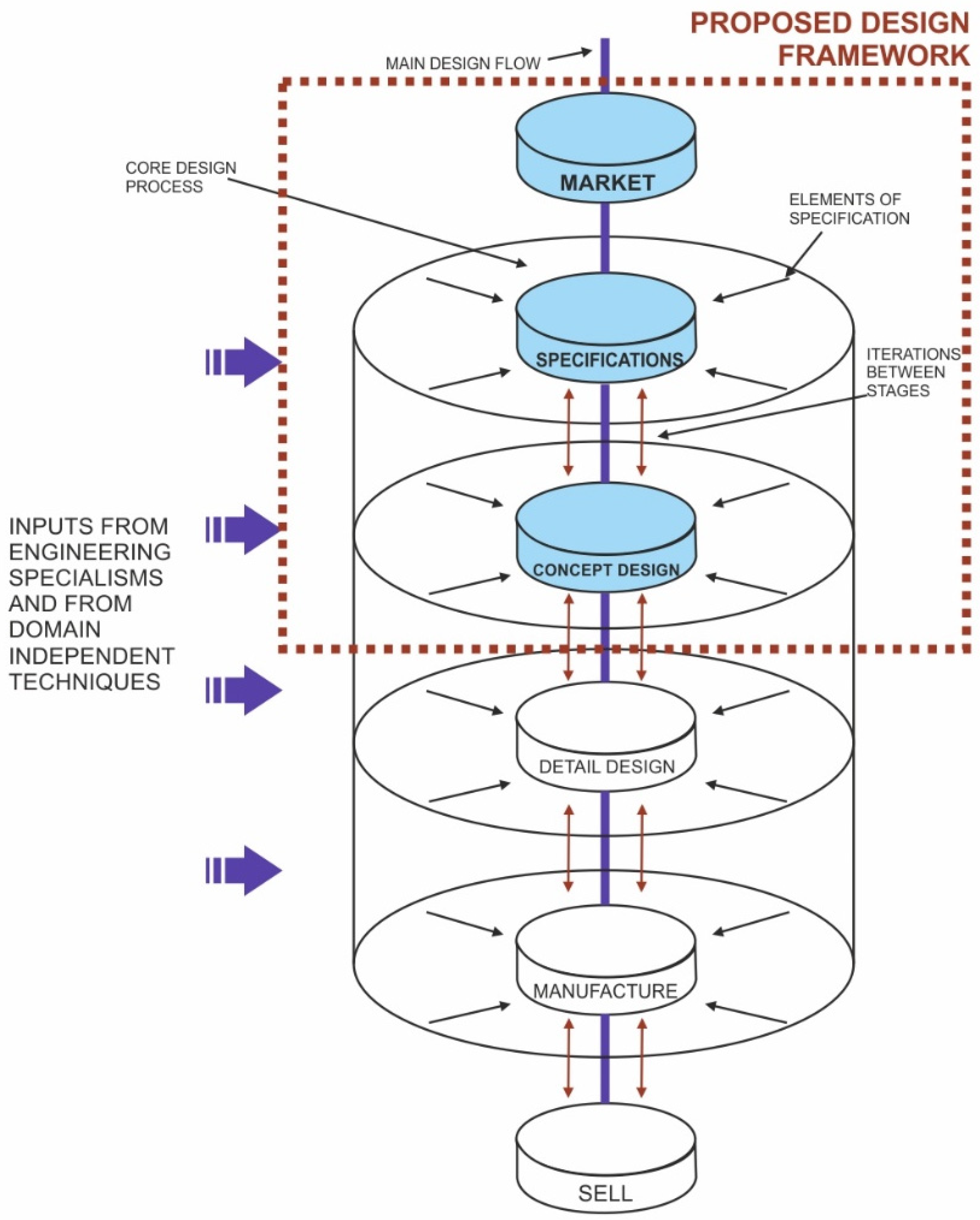

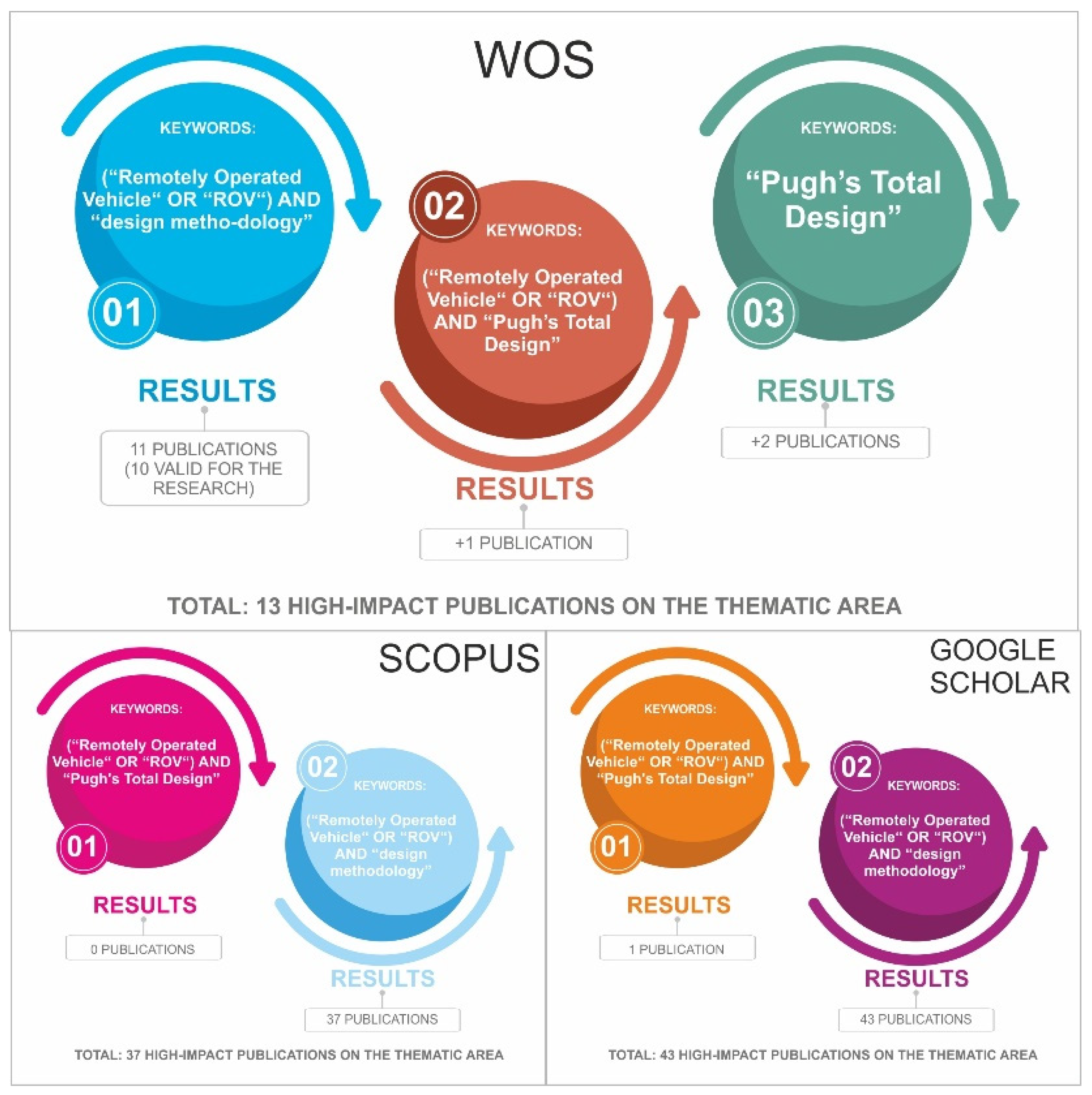
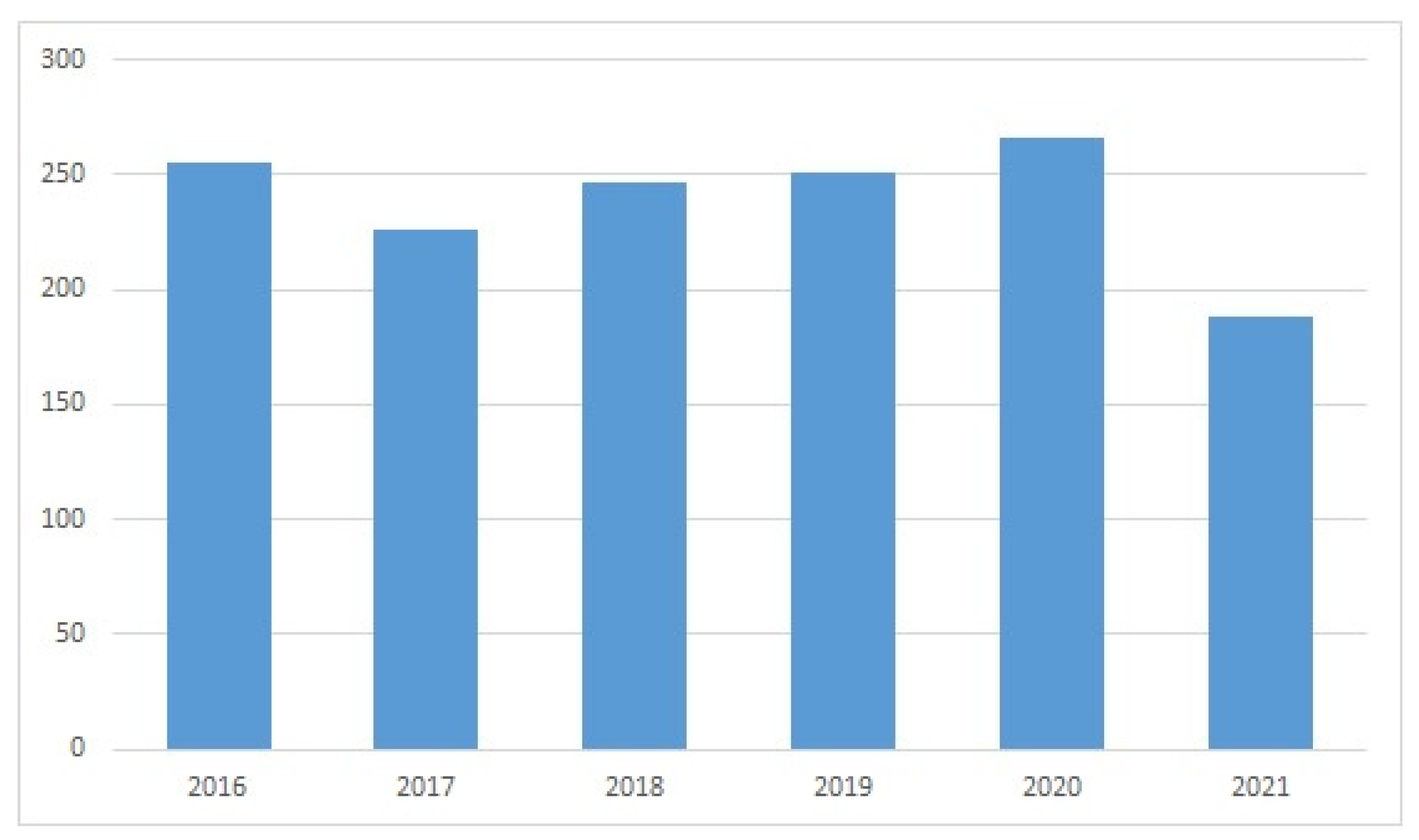
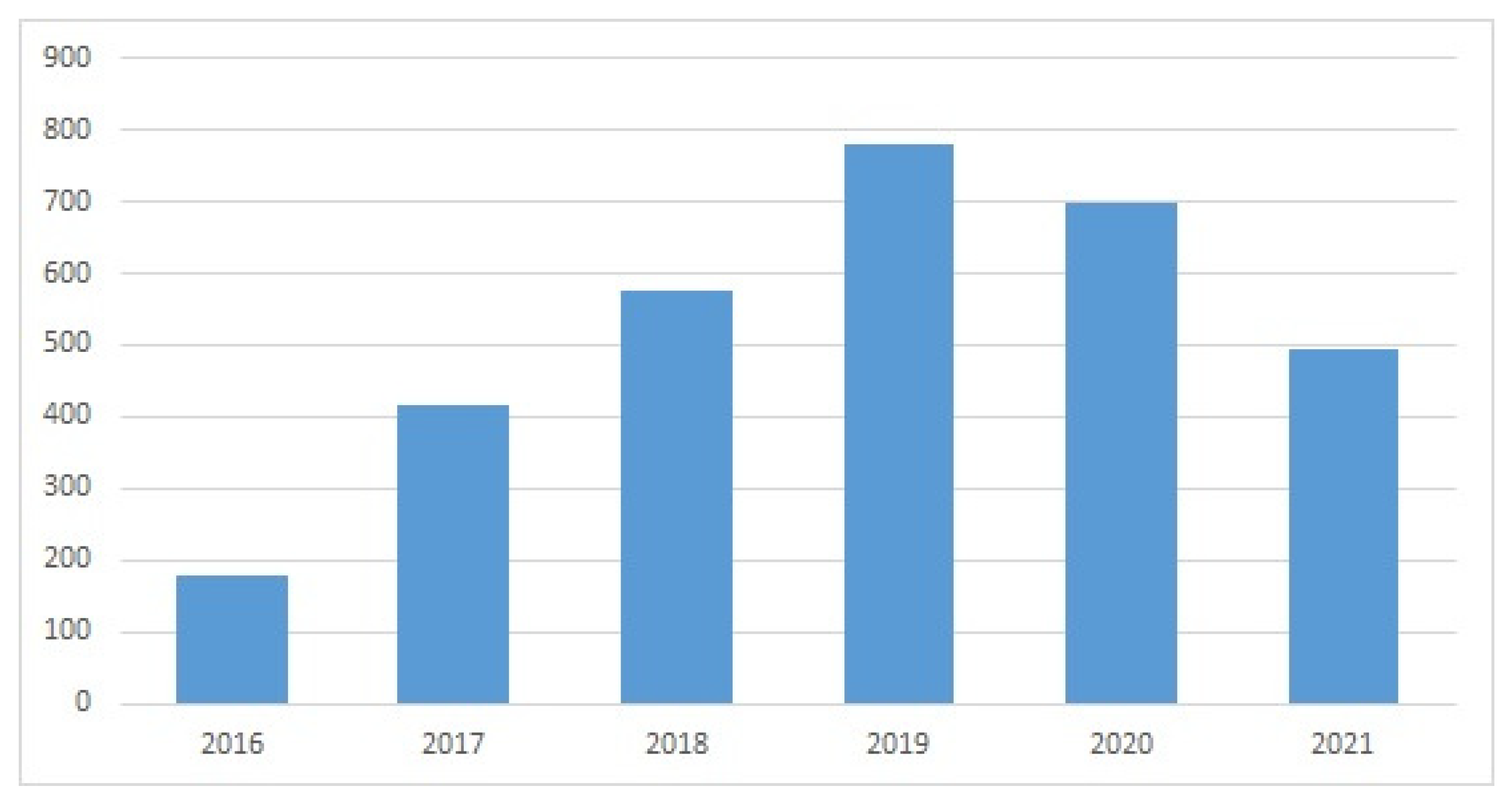
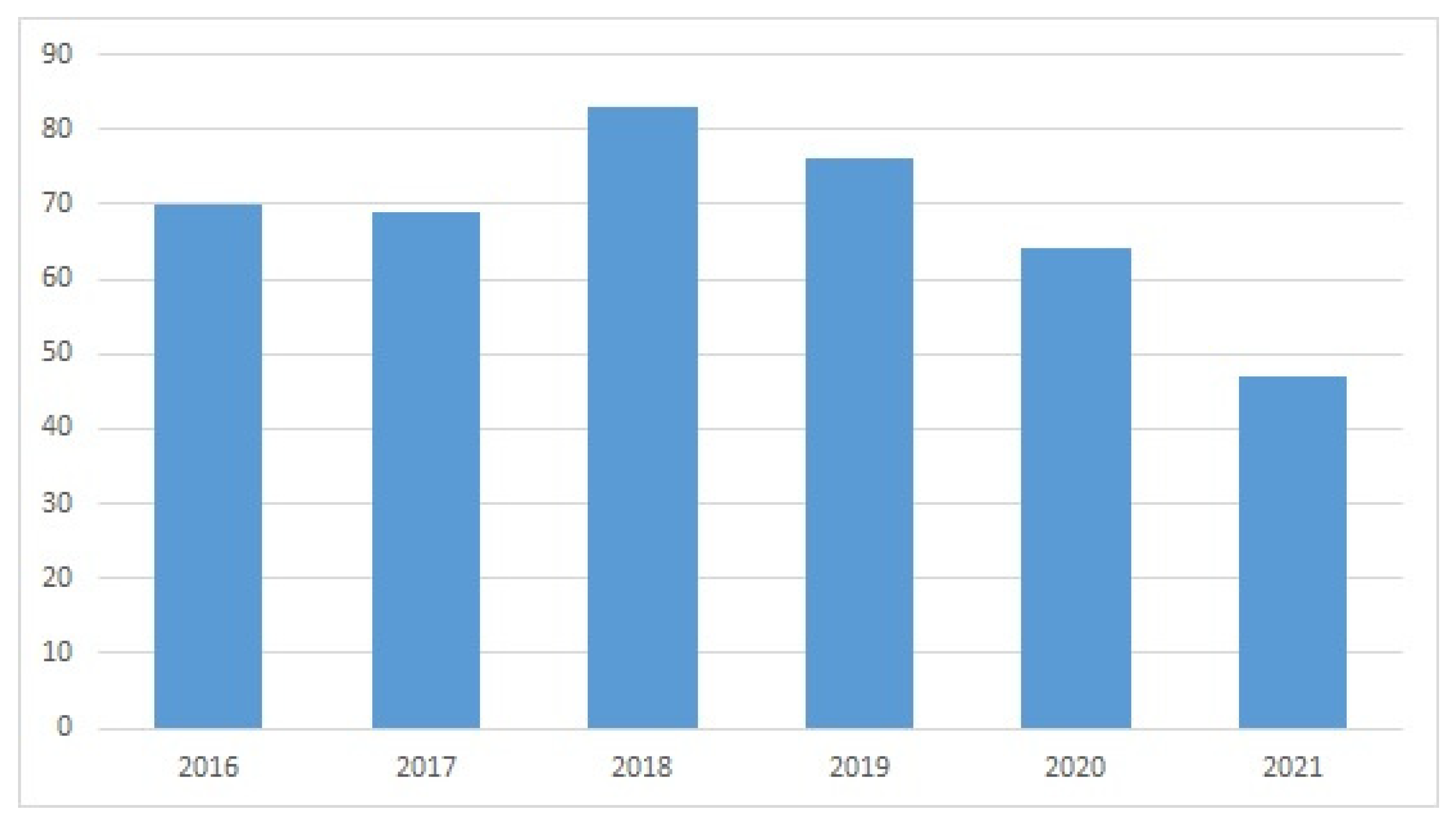
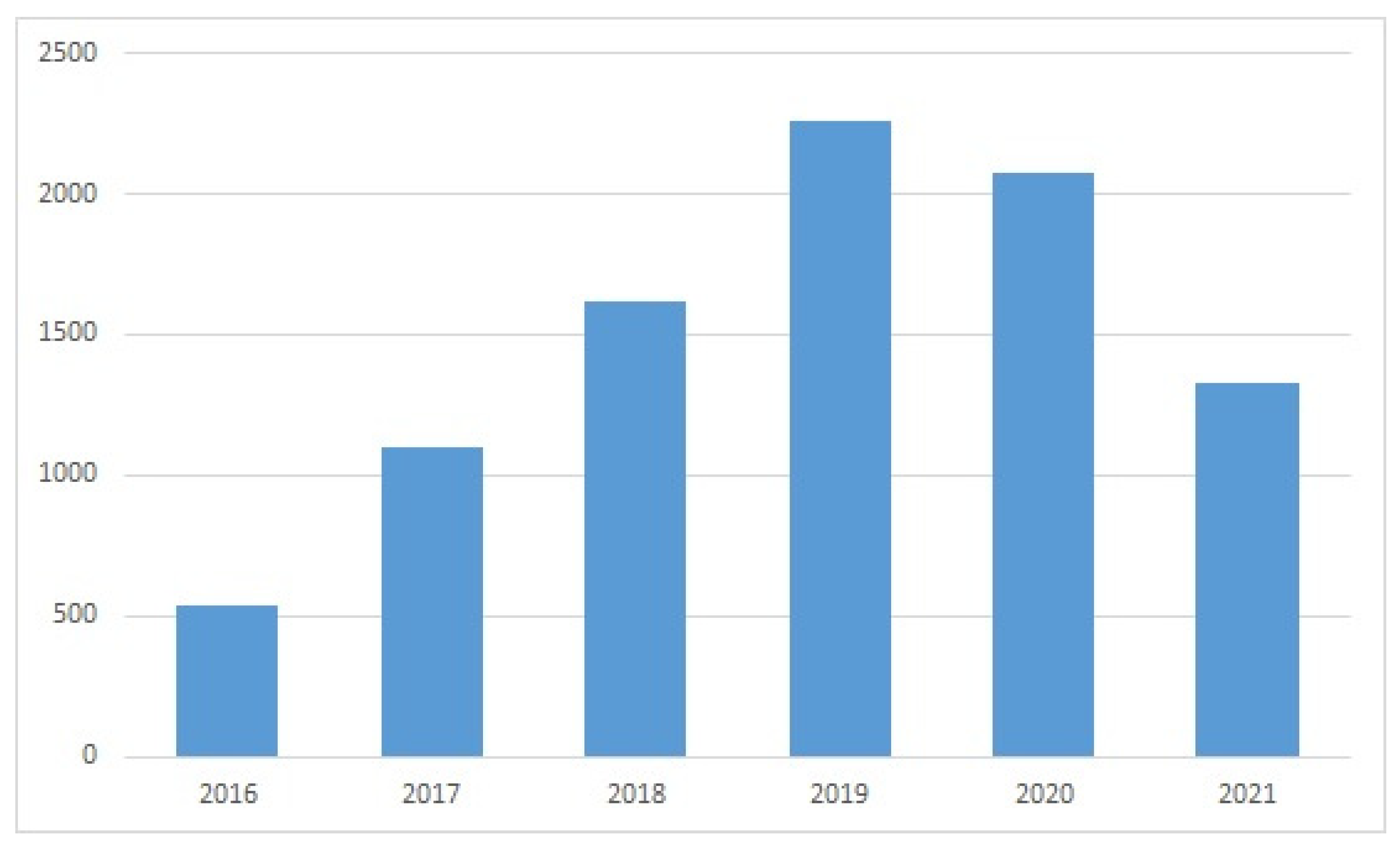

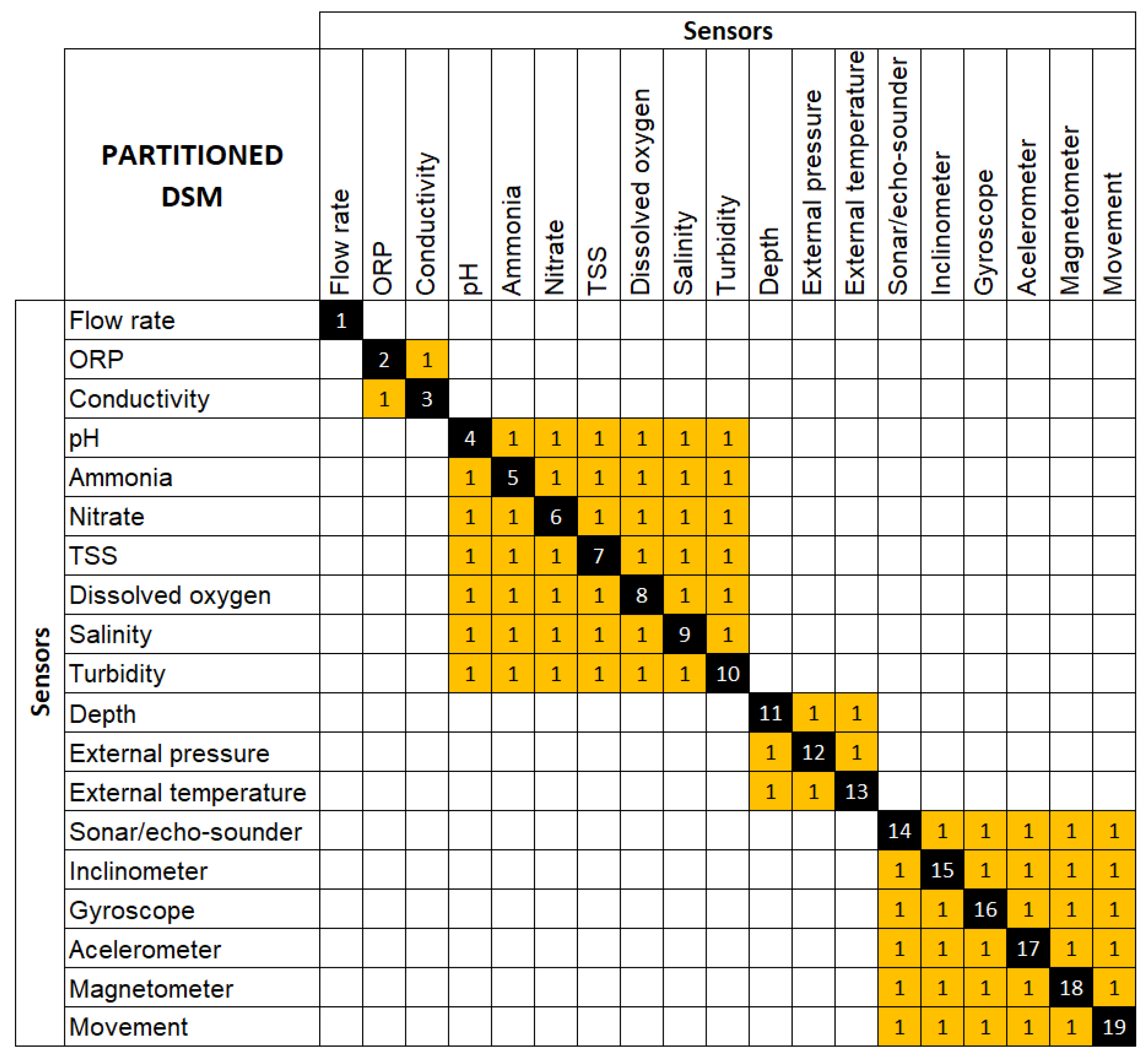
| Questions for Needs Elicitation |
|---|
| Will the vehicle operate in fresh or salt water? |
| Will be the ROV in controlled environments or in natural spaces? |
| What species can be found in the environment? |
| Should regular or planned maintenance be performed? |
| What type of maintenance will be performed? |
| What components present increased exposure? |
| What is the intended use of the product? |
| What information is collected with the ROV? |
| What is the previous experience using ROVs? |
| Are there speed restrictions? |
| What is the maximum inspection time? |
| Will special materials be necessary? |
| Is there a risk of collision? |
| Are there restrictions on the application of materials according to the environment? |
| Need | PDS | Specification | Units |
|---|---|---|---|
| Obtain information of water | Environment | Temperature | °C |
| Obtain information of sea bed | Pressure/depth | bar/m | |
| Obtain information of submerged structures | Water analysis | multiple units | |
| Obtain information of marine biodiversity | Distance measurement | m | |
| Allow displacement in the environment | Detection of objects and fauna | · | |
| Knowledge of state | Maintenance | Temperature | °C |
| Be easy to disassemble | Pressure | bar | |
| Be resistant to environment conditions | Internal state | · | |
| Use suitable materials for water | Service life | years | |
| Allow displacement in the environment | Performance | Speed | m/s |
| Have access to energy source | Depth | m | |
| Knowledge of internal state | Power | W | |
| Knowledge of position | Positioning (USBL) | m | |
| Communicate information | Autonomy | h | |
| Avoid turbulence in the environment | Materials | Impact resistance | kJ/m² |
| Be easy to manufacture | Weight | kg | |
| Use suitable materials for water | Pressure | bar | |
| Be resistant to environment conditions | Temperature | °C | |
| Be resistant to fauna | Cost | € | |
| Communicate information | Users | Usability | · |
| Be easy to assemble | Experience | · | |
| Be easy to operate | Control | · | |
| Be easy to transport | Operation | · |
| MOOSE Clasification | Sensor | Function | Units |
|---|---|---|---|
| User Context and End user. Usability. Functionality. Environment. | Flow rate | Measurement of speed of water by studying flow patterns. | m/s |
| Oxidation-Reduction Potential (ORP) | Measurement of the ability of a solution to act as an oxidizing or reducing agent. | mV | |
| pH | Measurement of concentration of hydrogen ions in water, a measure of the acidity or alkalinity of water. | pH | |
| Ammonia | Measurement of concentration of ammonia in water. | mg/L | |
| Nitrate | Measurement of concentration of nitrate in water. | mg/L | |
| Turbidity | Measurement of turbidity of water and monitoring the formation of precipitates and populations of algae. | NTU | |
| Total Suspended Solid (TTS) | Measurement of total concentration of suspended solids in water, a complementary measure to turbidity. | g/L | |
| Dissolved oxygen | Measurement of concentration of dissolved oxygen in water. | mg/L | |
| Conductivity | Measurement of the ability of a solution to conduct electricity. | S/m | |
| Salinity | Measurement of the content of dissolved salts in water. | mg/L-ppm | |
| Technical | Depth | Depth range control. | m |
| External pressure | Pressure measurement according to the depth reached. | bar | |
| External temperature | Measurement of water temperature. | °C | |
| Sonar/echo-sounder | Obstacle and fauna detection. | acoustic pulse | |
| Inclinometer | Measurement of the inclination and roll in the vehicle. | ° | |
| Gyroscope | Measurement of angular velocity of the vehicle in one or more axes. | ° | |
| Acelerometer | Measurement of vehicle acceleration in one or more axes. | m/s2 | |
| Magnetometer | Measurement of the strength or direction of the magnetic field. | T (tesla) | |
| Movement | Provide information about the stability and heading of the moving vehicle. | · | |
| Leak sensor | Allows the detection of leaks in the electronic POD. | · | |
| Internal pressure | Measurement of pressure inside the POD. | bar |
Publisher’s Note: MDPI stays neutral with regard to jurisdictional claims in published maps and institutional affiliations. |
© 2022 by the authors. Licensee MDPI, Basel, Switzerland. This article is an open access article distributed under the terms and conditions of the Creative Commons Attribution (CC BY) license (https://creativecommons.org/licenses/by/4.0/).
Share and Cite
Ramos, T.; Córdoba, A.; Luque, A.; de las Heras, A. Total Design in the Design and Development Process of a Remotely Operated Vehicle (ROV) with Particular Consideration of Sensorization. Sensors 2022, 22, 3284. https://doi.org/10.3390/s22093284
Ramos T, Córdoba A, Luque A, de las Heras A. Total Design in the Design and Development Process of a Remotely Operated Vehicle (ROV) with Particular Consideration of Sensorization. Sensors. 2022; 22(9):3284. https://doi.org/10.3390/s22093284
Chicago/Turabian StyleRamos, Teresa, Antonio Córdoba, Amalia Luque, and Ana de las Heras. 2022. "Total Design in the Design and Development Process of a Remotely Operated Vehicle (ROV) with Particular Consideration of Sensorization" Sensors 22, no. 9: 3284. https://doi.org/10.3390/s22093284







